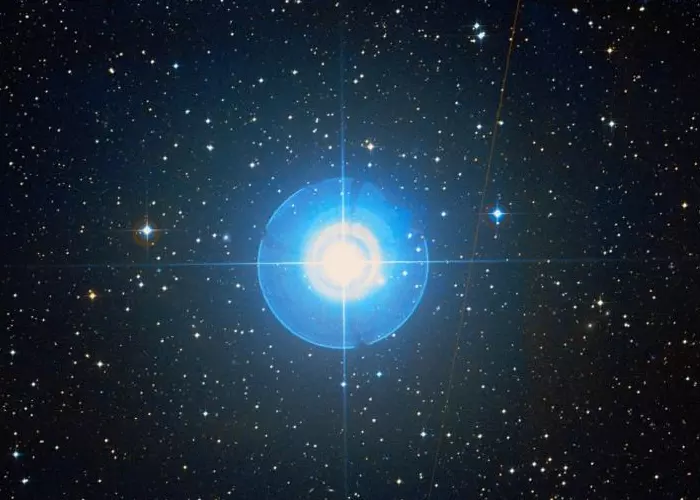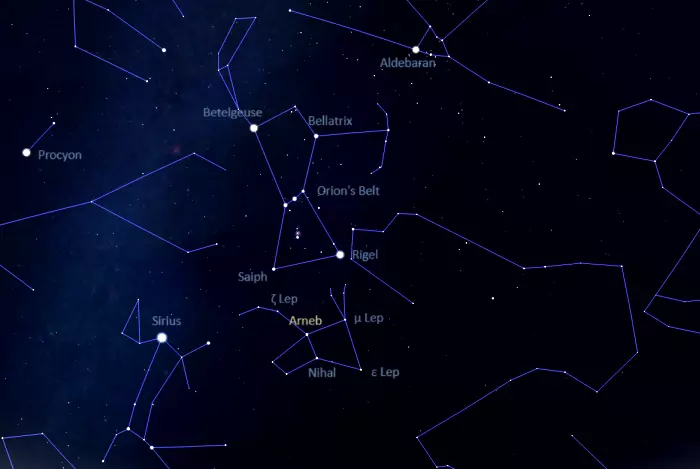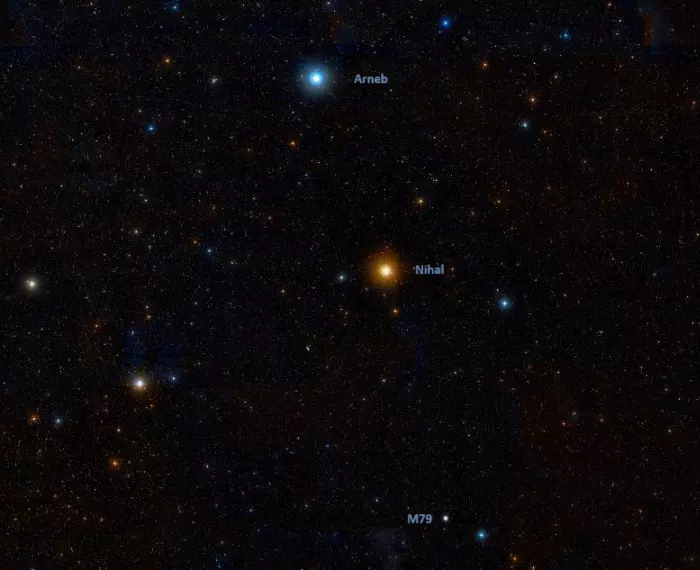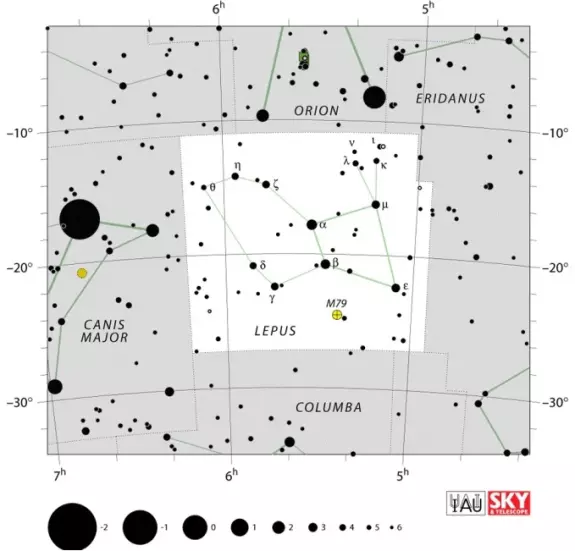Arneb, Alpha Leporis (α Lep), is an F-type supergiant star located approximately 2,200 light-years away in the constellation Lepus (the Hare). With an apparent magnitude of 2.589, it is the constellation’s brightest star. With a mass about 14 times that of the Sun, the supergiant is destined to end its life as a spectacular supernova.
Star type
Arneb is a yellow-white supergiant of the spectral type F0 Ib. It has a mass 13.9 times that of the Sun and a radius 75 times the Sun’s. With a surface temperature of 6,850 K, it shines with 12,023 solar luminosities. The star spins at 21 km/s. It has an estimated age of only 13 million years.
Even though it is still a young star, Arneb has evolved fast due to its high mass. It has burned through its supply of hydrogen fuel and expanded into a supergiant. The star may still be expanding into a larger red supergiant or it may have passed through the supergiant stage and is currently in the process of contracting and heating up. Either way, its high mass seals its fate as a brilliant supernova in the relatively near future (astronomically speaking).

Arneb (Alpha Leporis), image: Wikisky
Facts
In early Arabic astronomy, Arneb (Alpha Leporis), Nihal (Beta Leporis), Gamma Leporis, and Delta Leporis formed an asterism called Al Kursiyy al Jabbar or Al ‘Arsh al Jauzah, meaning “the chair of the giant.” The star pattern was also called the Throne of Jauza or the Throne of Jawza.
Jawza (“the central one”) was the old Arabic name for the constellation Orion (the Hunter). It referred to a female figure in an Arabian legend, but the meaning of the figure is lost to history. The stars of Lepus formed its throne or chair. The figure is remembered in the name of Alpha Orionis, Betelgeuse, which is derived from Yad al-Jauzā, “the hand of the central one.”
The asterism formed by the bright stars of Lepus was also known as Camels Quenching Their Thirst (al-Nihāl). The name Nihal formally applies to the constellation’s second brightest star, Beta Leporis.
Arneb has been a spectral standard for its class (F0 Ib) since 1943. The star’s spectrum is used as one of the stable anchor points to classify other stars.
Arneb is, on average, the 98th brightest star in the sky. It is one of the brightest F-type supergiants, along with Mirfak in the constellation Perseus, Wezen in Canis Major, Polaris in Ursa Minor, and Sadr in Cygnus.
Name
The name Arneb (pronunciation: /ˈɑːrnɛb/) comes from the Arabic ’arnab, meaning “hare.” The star was also historically known as Arsh.
The name Arneb was approved by the International Astronomical Union’s (IAU) Working Group on Star Names (WGSN) on July 20, 2016.
Arneb is one of the several lucidae (brightest stars in constellations) that take their name from their host constellation. Other lucidae named after their constellations include Altair (“the flying eagle”) in the constellation Aquila, Hamal (“the ram”) in Aries, Phact (“the ring dove”) in Columba, Kornephoros (“the club bearer”) in Hercules, Peacock in Pavo, Ankaa (“the phoenix”) in Phoenix, and Naos and Alsephina (“the ship”) in Puppis and Vela (formerly Argo Navis, the Ship Argo).
In Chinese astronomy, Arneb was known as 廁一 (Cè yī), the First Star of Toilet. It formed the Toilet asterism with Nihal (Beta Leporis), Gamma and Delta Leporis. The asterism was part of the larger Three Stars mansion, which represented the body of the White Tiger.
Location
Arneb is located near the bright, recognizable constellation figure of Orion, the celestial Hunter. It is the brightest star at Orion’s feet. It appears southeast of Rigel and southwest of Saiph, the stars that mark Orion’s legs or knees. The two hot blue supergiants are part of the hourglass-shaped figure of Orion, which dominates the evening sky during the northern hemisphere winter. They form a triangle with the fainter Arneb.

The location of Arneb (Alpha Leporis), image: Stellarium
Arneb and Nihal, the second brightest star in Lepus, can be used to find the bright globular cluster Messier 79. A line drawn from Arneb through Nihal and extended by about the same distance as that between the two stars leads towards M79. With an apparent magnitude of 7.7 and apparent size of 8.7 arcminutes, the cluster can be observed in binoculars and small telescopes. It has an estimated age of 11.7 billion years and lies approximately 42,000 light-years away.

Arneb, Nihal and Messier 79, image: Wikisky
Constellation
Arneb is located in the constellation Lepus. Representing the celestial Hare, Lepus is one of the 48 Greek constellations catalogued by the Greco-Roman astronomer Claudius Ptolemy in his Almagest in the 2nd century CE. It is typically depicted as a hare chased by Orion (the Hunter) and his two dogs, Canis Major and Canis Minor. However, the constellation is not associated with any particular figure in Greek mythology.
Lepus is one of the smaller constellations. Stretching across 290 square degrees of the sky just south of the celestial equator, it is the 51st largest of the 88 constellations.
Other than Arneb, notable stars in Lepus include the yellow bright giant Nihal (Beta Leporis), the orange giant Epsilon Leporis, the orange subgiant or giant Delta Leporis, the hot blue subgiant Mu Leporis, and the Mira variables T Leporis and R Leporis (Hind’s Crimson Star).

Lepus constellation map by IAU and Sky&Telescope magazine
Deep sky objects in Lepus include the globular cluster Messier 79, the planetary nebula IC 418 (the Spirograph Nebula), the barred spiral galaxy NGC 1964, the lenticular galaxies NGC 1979 and NGC 1993, and the irregular galaxy NGC 1821.
The best time of the year to see the stars and deep sky objects in Lepus is during the month of January, when the constellation climbs higher above the horizon in the evening. The entire constellation is visible from locations south of the latitude 63° N.
The 10 brightest stars in Lepus are Arneb (Alpha Lep, mag. 2.589), Nihal (Beta Lep, mag. 2.84), Epsilon Leporis (mag. 3.166), Mu Leporis (mag. 3.259), Zeta Leporis (mag. 3.524), Gamma Leporis (mag. 3.587), Eta Leporis (mag. 3.72), Delta Leporis (mag. 3.85), Lambda Leporis (mag. 4.286), and Kappa Leporis (mag. 4.43).
Arneb – Alpha Leporis
| Spectral class | F0 Ib |
| U-B colour index | +0.386 |
| B-V colour index | +0.217 |
| Apparent magnitude | 2.589 |
| Absolute magnitude | −6.574 |
| Distance | 2,200 ± 200 light-years (680 ± 60 parsecs) |
| Parallax | 1.47 ± 0.14 mas |
| Radial velocity | +25.10 ± 0.1 km/s |
| Proper motion | RA: +3.56 ± 0.12 mas/yr |
| Dec.: +1.18 ± 0.11 mas/yr | |
| Mass | 13.9 ± 0.8 M☉ |
| Luminosity | 12,023 L☉ |
| Radius | 75 R☉ |
| Temperature | 6,850 ± 80 K |
| Metallicity | +0.04 dex |
| Age | 13 million years |
| Rotational velocity | 21 km/s |
| Surface gravity | 1.34 ± 0.07 cgs |
| Constellation | Lepus |
| Right ascension | 05h 32m 43.8161188s |
| Declination | −17° 49′ 20.241380″ |
| Names and designations | Arneb, Alpha Leporis, α Lep, 11 Leporis, HD 36673, HR 1865, HIP 25985, SAO 150547, BD−17°1166, FK5 207, GC 6875, GCRV 3373, PLX 1265.00, PPM 215925, IRAS 05305-1751, 2MASS J05324381-1749198, UBV 5395, TYC 5920-1685-1, Gaia DR2 2971266110610441856, ADS 4146 A, CCDM J05327-1750A, WDS J05327-1749A |